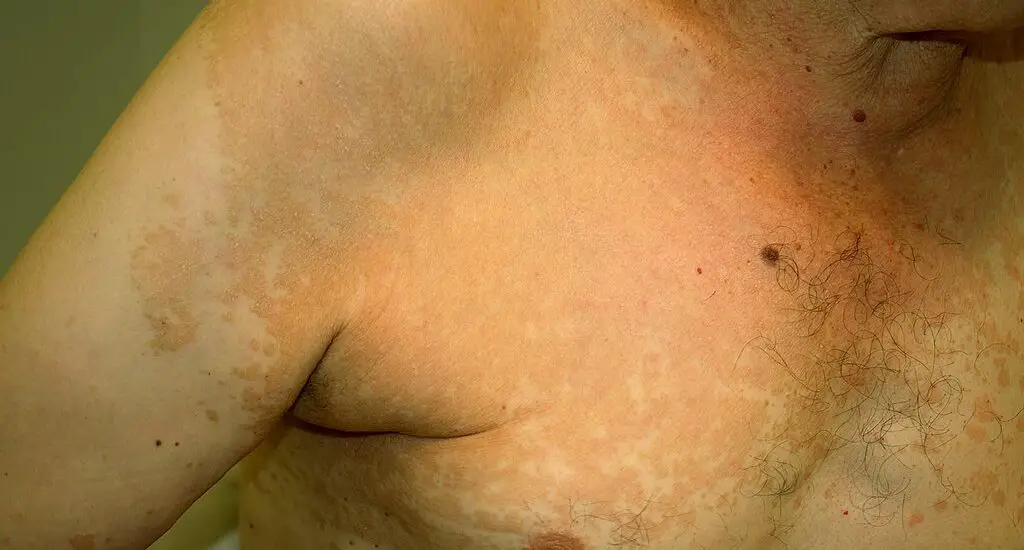If you’re asking the question, “Can fungal infection cause skin discoloration?”, you’re not alone. In this article, we will comprehensively address the link between fungal infections and skin discoloration.

Table of Contents
Can Fungal Infection Cause Skin Discoloration?
Yes, fungal infections can lead to skin discoloration. This usually happens when the fungi interact with the melanin in your skin, causing areas to darken or lighten. It’s important to identify the specific type of fungal infection causing the discoloration for proper treatment.
Tinea Versicolor is an example of a fungal infection that directly leads to changes in skin pigmentation. These changes can result in patches on the skin that are either lighter or darker than the surrounding area. Source: American Academy of Dermatology
Types of Fungal Infections that Lead to Skin Discoloration
It’s crucial to note that not all fungal infections result in skin discoloration. However, several types are known to:
Tinea Versicolor: Characterized by small, discolored patches on the skin, which can be lighter or darker than the surrounding skin.
Candidiasis: Primarily causes red, itchy rashes, but the affected area may later turn darker than the surrounding skin due to post-inflammatory hyperpigmentation.
Ringworm: Initially causes red or silver rashes that can eventually darken, particularly if scratched or irritated.
It’s important to consult a healthcare provider for proper diagnosis and treatment.
How to Diagnose Fungal Infection-Induced Skin Discoloration
If you notice a change in your skin color and suspect a fungal infection is the cause, consult a healthcare provider for a proper diagnosis. The diagnostic process often involves:
Visual Examination: The doctor will first examine the affected areas closely.
Skin Scraping Test: A sample of your skin may be scraped off for microscopic examination.
Culture Tests: This involves growing the collected skin samples to identify the specific type of fungi causing the infection.
These diagnostic steps are crucial for determining the type of treatment you will need. Source: Mayo Clinic
Treatment Options
Treatment varies based on the type and severity of the fungal infection. Here are common treatment methods:
Topical Antifungals: These are creams or ointments that you apply directly to the skin. Examples include clotrimazole and ketoconazole.
You can confirm with your healthcare provider if you can use this Terrasil Antifungal Cream with Clotrimazole listed on Amazon.
Oral Antifungals: In more severe or persistent cases, oral medications like fluconazole may be prescribed.
Light Therapy: In rare instances, ultraviolet light treatment may be recommended to balance the skin’s pigmentation.
Always adhere to the treatment prescribed by your healthcare provider.
Check out these other articles…
How Do You Know If Rash Is Fungal? Signs to Look Out For
Black Skin After Fungal Infection: Causes & Solutions
Dry Skin After Fungal Infection: How to Heal & Prevent
Skin Peeling After Fungal Infection: How to Deal with It
Red Skin After Fungal Infection: 3 Causes & Sure Solutions
How Long Does Fungal Infection on Skin Last? Complete Guide
Can Fungal Infection Cause Skin Rash? – Unraveling the Truth
Prevention Tips
Preventing fungal infections—and the resultant skin discoloration—involves proactive measures:
Good Hygiene: Wash your body daily and make sure to dry yourself thoroughly, especially in folds of the skin and other areas prone to moisture.
Avoid Tight Clothing: Tight clothes can trap moisture, creating a conducive environment for fungal growth. Opt for loose, breathable fabrics like cotton.
Stay Dry: After activities that cause you to sweat, shower, and change into dry clothes as soon as possible.
Practicing these preventive measures can significantly lower your risk of developing fungal infections that cause skin discoloration.

